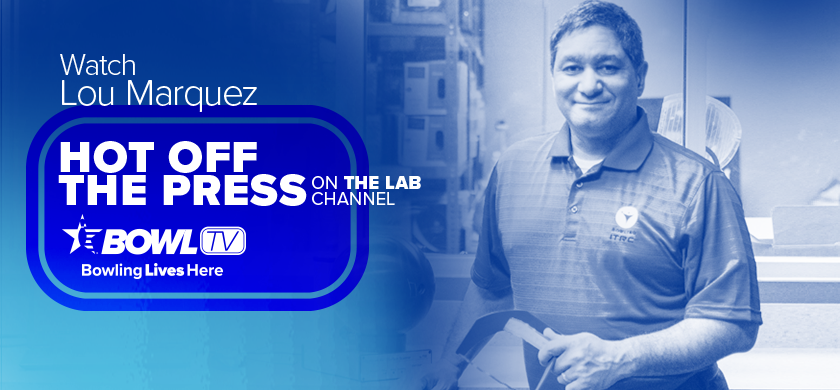By Lou Marquez on Jul 13, 2019 11:37:11 AM
We've been talking a lot about surface recently-what it is, why it's important and how to use it (or the lack of it) to your advantage while you're bowling. But if you've been making adjustments with surface pads during practice or to adjust to different lane conditions, how do you get your ball back to a surface you're comfortable with?
 We'll start with a ball that hasn't been resurfaced in a long time, if ever. It has several games on it, and we can see marks from rolling down the lane, a few nicks from getting bumped around in the pit and it's just not going to be reliable in competition until we get it back to a surface we're comfortable seeing.
We'll start with a ball that hasn't been resurfaced in a long time, if ever. It has several games on it, and we can see marks from rolling down the lane, a few nicks from getting bumped around in the pit and it's just not going to be reliable in competition until we get it back to a surface we're comfortable seeing.
This particular customer likes to see his ball surfaced at 2,000 grit. Before we can get to that magic number, though, we need to, essentially, start over.
Going Deep
Starting over means we need to get rid of all the crud, dings and other undesirable features on the bowling ball. This will give us a starting point that's consistent throughout the bowling ball. To do this, we're going to use the ball spinner and hit the ball with water and a 360-grit pad.
We want to cover the whole bowling ball, so we'll need to rotate it to the other side and spin it again.
It's a strong pad so it will bust through the scuffs and get us down to a spot where we can start refining the surface to ultimately get it where we want it for our next trip to the lanes.
We can clearly see the little grooves on the ball after hitting it with 360. Because we rotated it between applications, the grooves are going in two directions. We're trying to randomize the grooves to develop the best possible base texture so we can apply what we want on top of it.
If we want to, we can stop right now. If this is the surface we want on our bowling ball, we can take it to the lanes and start rolling. But, as we said before, we're going to get this thing to 2,000.
Applying 500
Our 500-grit pad is still a strong pad, but it's weaker than 360. By starting with 360 and then going to 500, we continue to randomize texture on the ball, but as we look closer, it's getting a lot more even. The grooves are random, the depth is getting more consistent and we're getting this ball into a good spot.
From here, again we could stop if we wanted. Or, we could apply a polish to the ball, as this is often the point a manufacturer would apply the polish if that were the desired finish. Again, that's not our desired finish in this case-we want to get to 2,000 for our customer.
Finishing the Job
We created a nice base surface with a 360 pad and smoothed it out some with a 500 pad. Now, we'll hit it with 2,000.
Don't blink on this one. It's very quick. Put some water on the pad, turn on the spinner, apply the pad to the ball and we're done really quickly. What we're trying to do is knock off some of the remaining peaks to give us a consistent finish at 2,000.
Not only is this what our customer wants, but this is also where a lot of manufacturers will take their bowling balls before putting them in the box for sale.
There are a lot of different things you can do in this process. You can change the pressure you apply, the time you spend, the grit of the pads you use, the polish you do or don't apply, and the best way to figure out what works for you is to experiment.
When we take the ball out of the spinner, it looks like it just came out of the box (except it already has holes in it). Knowing how to resurface your bowling ball is vital, not only to keep life in the ball, but also when you bowl on multiple conditions that require different surfaces.
Lou




comments